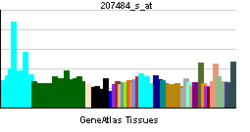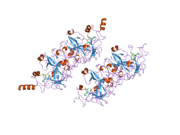EHMT2
| View/Edit Human | View/Edit Mouse |
Euchromatic histone-lysine N-methyltransferase 2 (EHMT2), also known as G9a, is a histone methyltransferase that in humans is encoded by the EHMT2 gene.[3][4][5]
Function
A cluster of genes, BAT1-BAT5, has been localized in the vicinity of the genes for TNF alpha and TNF beta. This gene is found near this cluster; it was mapped near the gene for C2 within a 120-kb region that included a HSP70 gene pair. These genes are all within the human major histocompatibility complex class III region. This gene was thought to be two different genes, NG36 and G9a, adjacent to each other but a recent publication shows that there is only a single gene. The protein encoded by this gene is thought to be involved in intracellular protein-protein interaction. There are three alternatively spliced transcript variants of this gene but only two are fully described.[5]
G9a and G9a-like protein, another histone-lysine N-methyltransferase, catalyze the dimethylated state of H3K9me2. G9a is an important control mechanism for epigenetic regulation within the nucleus accumbens, particularly during the development of an addiction, since G9a opposes the induction of ΔFosB expression and is suppressed by ΔFosB.[6] G9a exerts opposite effects to that of ΔFosB on drug-related behavior (e.g., self-administration) and synaptic remodeling (e.g., dendritic arborization – the development of additional tree-like dendritic branches and spines) in the nucleus accumbens, and therefore opposes ΔFosB's function as well as increases in its expression.[6]
Interactions
EHMT2 has been shown to interact with KIAA0515 and the prostate tissue associated homeodomain protein NKX3.1.[7][8]
References
- ↑ "Human PubMed Reference:".
- ↑ "Mouse PubMed Reference:".
- ↑ Milner CM, Campbell RD (Mar 1993). "The G9a gene in the human major histocompatibility complex encodes a novel protein containing ankyrin-like repeats". The Biochemical Journal. 290 (Pt 3): 811–8. PMC 1132354
 . PMID 8457211.
. PMID 8457211. - ↑ Tachibana M, Sugimoto K, Fukushima T, Shinkai Y (Jul 2001). "Set domain-containing protein, G9a, is a novel lysine-preferring mammalian histone methyltransferase with hyperactivity and specific selectivity to lysines 9 and 27 of histone H3". The Journal of Biological Chemistry. 276 (27): 25309–17. doi:10.1074/jbc.M101914200. PMID 11316813.
- 1 2 "Entrez Gene: EHMT2 euchromatic histone-lysine N-methyltransferase 2".
- 1 2 Nestler EJ (January 2014). "Epigenetic mechanisms of drug addiction". Neuropharmacology. 76 Pt B: 259–268. doi:10.1016/j.neuropharm.2013.04.004. PMC 3766384
 . PMID 23643695.
. PMID 23643695. Short-term increases in histone acetylation generally promote behavioral responses to the drugs, while sustained increases oppose cocaine’s effects, based on the actions of systemic or intra-NAc administration of HDAC inhibitors. ... Genetic or pharmacological blockade of G9a in the NAc potentiates behavioral responses to cocaine and opiates, whereas increasing G9a function exerts the opposite effect (Maze et al., 2010; Sun et al., 2012a). Such drug-induced downregulation of G9a and H3K9me2 also sensitizes animals to the deleterious effects of subsequent chronic stress (Covington et al., 2011). Downregulation of G9a increases the dendritic arborization of NAc neurons, and is associated with increased expression of numerous proteins implicated in synaptic function, which directly connects altered G9a/H3K9me2 in the synaptic plasticity associated with addiction (Maze et al., 2010).
G9a appears to be a critical control point for epigenetic regulation in NAc, as we know it functions in two negative feedback loops. It opposes the induction of ΔFosB, a long-lasting transcription factor important for drug addiction (Robison and Nestler, 2011), while ΔFosB in turn suppresses G9a expression (Maze et al., 2010; Sun et al., 2012a). ... Also, G9a is induced in NAc upon prolonged HDAC inhibition, which explains the paradoxical attenuation of cocaine’s behavioral effects seen under these conditions, as noted above (Kennedy et al., 2013). GABAA receptor subunit genes are among those that are controlled by this feedback loop. Thus, chronic cocaine, or prolonged HDAC inhibition, induces several GABAA receptor subunits in NAc, which is associated with increased frequency of inhibitory postsynaptic currents (IPSCs). In striking contrast, combined exposure to cocaine and HDAC inhibition, which triggers the induction of G9a and increased global levels of H3K9me2, leads to blockade of GABAA receptor and IPSC regulation. - ↑ Rual JF, Venkatesan K, Hao T, Hirozane-Kishikawa T, Dricot A, Li N, Berriz GF, Gibbons FD, Dreze M, Ayivi-Guedehoussou N, Klitgord N, Simon C, Boxem M, Milstein S, Rosenberg J, Goldberg DS, Zhang LV, Wong SL, Franklin G, Li S, Albala JS, Lim J, Fraughton C, Llamosas E, Cevik S, Bex C, Lamesch P, Sikorski RS, Vandenhaute J, Zoghbi HY, Smolyar A, Bosak S, Sequerra R, Doucette-Stamm L, Cusick ME, Hill DE, Roth FP, Vidal M (Oct 2005). "Towards a proteome-scale map of the human protein-protein interaction network". Nature. 437 (7062): 1173–8. doi:10.1038/nature04209. PMID 16189514.
- ↑ Dutta A, et al. (Jun 2016). "Identification of an NKX3.1-G9a-UTY transcriptional regulatory network that controls prostate differentiation". Science.
Further reading
- Spies T, Bresnahan M, Strominger JL (Nov 1989). "Human major histocompatibility complex contains a minimum of 19 genes between the complement cluster and HLA-B". Proceedings of the National Academy of Sciences of the United States of America. 86 (22): 8955–8. doi:10.1073/pnas.86.22.8955. PMC 298409
 . PMID 2813433.
. PMID 2813433. - Brown SE, Campbell RD, Sanderson CM (Dec 2001). "Novel NG36/G9a gene products encoded within the human and mouse MHC class III regions". Mammalian Genome : Official Journal of the International Mammalian Genome Society. 12 (12): 916–24. doi:10.1007/s00335-001-3029-3. PMID 11707778.
- Ogawa H, Ishiguro K, Gaubatz S, Livingston DM, Nakatani Y (May 2002). "A complex with chromatin modifiers that occupies E2F- and Myc-responsive genes in G0 cells". Science. 296 (5570): 1132–6. doi:10.1126/science.1069861. PMID 12004135.
- Tachibana M, Sugimoto K, Nozaki M, Ueda J, Ohta T, Ohki M, Fukuda M, Takeda N, Niida H, Kato H, Shinkai Y (Jul 2002). "G9a histone methyltransferase plays a dominant role in euchromatic histone H3 lysine 9 methylation and is essential for early embryogenesis". Genes & Development. 16 (14): 1779–91. doi:10.1101/gad.989402. PMC 186403
 . PMID 12130538.
. PMID 12130538. - Shi Y, Sawada J, Sui G, Affar el B, Whetstine JR, Lan F, Ogawa H, Luke MP, Nakatani Y, Shi Y (Apr 2003). "Coordinated histone modifications mediated by a CtBP co-repressor complex". Nature. 422 (6933): 735–8. doi:10.1038/nature01550. PMID 12700765.
- Xie T, Rowen L, Aguado B, Ahearn ME, Madan A, Qin S, Campbell RD, Hood L (Dec 2003). "Analysis of the gene-dense major histocompatibility complex class III region and its comparison to mouse". Genome Research. 13 (12): 2621–36. doi:10.1101/gr.1736803. PMC 403804
 . PMID 14656967.
. PMID 14656967. - Roopra A, Qazi R, Schoenike B, Daley TJ, Morrison JF (Jun 2004). "Localized domains of G9a-mediated histone methylation are required for silencing of neuronal genes". Molecular Cell. 14 (6): 727–38. doi:10.1016/j.molcel.2004.05.026. PMID 15200951.
- Nishio H, Walsh MJ (Aug 2004). "CCAAT displacement protein/cut homolog recruits G9a histone lysine methyltransferase to repress transcription". Proceedings of the National Academy of Sciences of the United States of America. 101 (31): 11257–62. doi:10.1073/pnas.0401343101. PMC 509191
 . PMID 15269344.
. PMID 15269344. - Collins RE, Tachibana M, Tamaru H, Smith KM, Jia D, Zhang X, Selker EU, Shinkai Y, Cheng X (Feb 2005). "In vitro and in vivo analyses of a Phe/Tyr switch controlling product specificity of histone lysine methyltransferases". The Journal of Biological Chemistry. 280 (7): 5563–70. doi:10.1074/jbc.M410483200. PMC 2696276
 . PMID 15590646.
. PMID 15590646. - Rual JF, Venkatesan K, Hao T, Hirozane-Kishikawa T, Dricot A, Li N, Berriz GF, Gibbons FD, Dreze M, Ayivi-Guedehoussou N, Klitgord N, Simon C, Boxem M, Milstein S, Rosenberg J, Goldberg DS, Zhang LV, Wong SL, Franklin G, Li S, Albala JS, Lim J, Fraughton C, Llamosas E, Cevik S, Bex C, Lamesch P, Sikorski RS, Vandenhaute J, Zoghbi HY, Smolyar A, Bosak S, Sequerra R, Doucette-Stamm L, Cusick ME, Hill DE, Roth FP, Vidal M (Oct 2005). "Towards a proteome-scale map of the human protein-protein interaction network". Nature. 437 (7062): 1173–8. doi:10.1038/nature04209. PMID 16189514.
- Duan Z, Zarebski A, Montoya-Durango D, Grimes HL, Horwitz M (Dec 2005). "Gfi1 coordinates epigenetic repression of p21Cip/WAF1 by recruitment of histone lysine methyltransferase G9a and histone deacetylase 1". Molecular and Cellular Biology. 25 (23): 10338–51. doi:10.1128/MCB.25.23.10338-10351.2005. PMC 1291230
 . PMID 16287849.
. PMID 16287849. - Kimura K, Wakamatsu A, Suzuki Y, Ota T, Nishikawa T, Yamashita R, Yamamoto J, Sekine M, Tsuritani K, Wakaguri H, Ishii S, Sugiyama T, Saito K, Isono Y, Irie R, Kushida N, Yoneyama T, Otsuka R, Kanda K, Yokoi T, Kondo H, Wagatsuma M, Murakawa K, Ishida S, Ishibashi T, Takahashi-Fujii A, Tanase T, Nagai K, Kikuchi H, Nakai K, Isogai T, Sugano S (Jan 2006). "Diversification of transcriptional modulation: large-scale identification and characterization of putative alternative promoters of human genes". Genome Research. 16 (1): 55–65. doi:10.1101/gr.4039406. PMC 1356129
 . PMID 16344560.
. PMID 16344560. - Beausoleil SA, Villén J, Gerber SA, Rush J, Gygi SP (Oct 2006). "A probability-based approach for high-throughput protein phosphorylation analysis and site localization". Nature Biotechnology. 24 (10): 1285–92. doi:10.1038/nbt1240. PMID 16964243.
- Reeves M, Murphy J, Greaves R, Fairley J, Brehm A, Sinclair J (Oct 2006). "Autorepression of the human cytomegalovirus major immediate-early promoter/enhancer at late times of infection is mediated by the recruitment of chromatin remodeling enzymes by IE86". Journal of Virology. 80 (20): 9998–10009. doi:10.1128/JVI.01297-06. PMC 1617317
 . PMID 17005678.
. PMID 17005678. - Estève PO, Chin HG, Smallwood A, Feehery GR, Gangisetty O, Karpf AR, Carey MF, Pradhan S (Nov 2006). "Direct interaction between DNMT1 and G9a coordinates DNA and histone methylation during replication". Genes & Development. 20 (22): 3089–103. doi:10.1101/gad.1463706. PMC 1635145
 . PMID 17085482.
. PMID 17085482.



